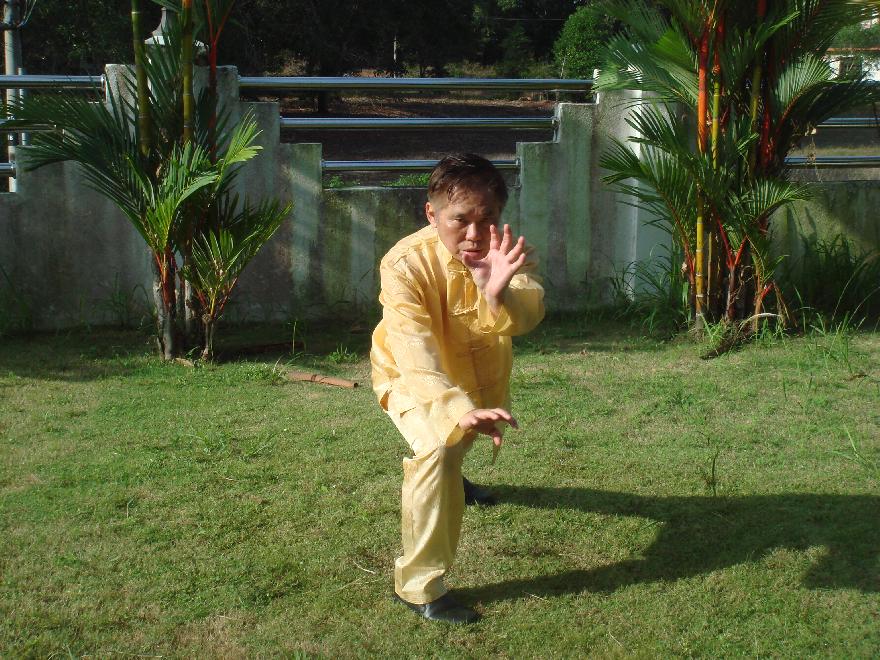LAM SAI WENG LINEAGE AND YOUR LINEAGE HAVE SIMILARITIES

"Hungry Tiger Snatches Goat" from Uncle Righteousness' Tiger-Crane Set
Question
The Lam Sai Wing lineage and your lineage have similarities, but your lineage makes more sense to me. The Lam Sai Wing lineage is more physical and external, yours is more internal.
— Csaba, Canada
Answer
Wong Fei Hoong and Lam Sai Weng were great Shaolin masters.
What they taught was similar to what I learned from my sifu, Uncle Righteousness, because they all traced back to the same source, i.e. the secret Shaolin Temple on the Nine-Lotus Mountain in Fujian Province of south China.
Wong Fei Hoong was Lam Sai Weng's sifu. Wong Fei Hoong's sifu was his father, Wong Kai Ying. Wong Kai Ying's sifu was Luk Ah Choy.
Uncle Righteousness' sifu was Ng Yew Loong. Ng Yew Loong's sifu was Chan Fook. Chan Fook's sifu was the Venerable Harng Yein.
The Venerable Harng Yein was the senior classmate of Luk Ah Choy. Both learned from the Venerable Chee Seen, the abbot of the secret southern Shaolin Temple.
Hence, the lineages are as follows:
Chee Seen -> Luk Ah Choy -> Wong Kai Ying -> Wong Fei Hoong -> Lam Sai Weng
Chee Seen -> Harng Yin -> Chan Fook -> Ng Yew Loong -> Uncle Righteousness
The Shaolin Kungfu I learned from Uncle Righteousness was also quite physical, similar to what practitioners from Lam Sai Weng's lineage practice. The internal aspect, known as noi kung (or nei kung in Mandarin), was taught only to inner chamber disciples.
In Lam Sai Weng's lineage, the main approach to internal force is the Iron-Wire Set. In Uncle Righteousness' lineage it was the Triple-Stretch Set.
Nevertheless, as you have rightly mentioned, the Shaolin Kungfu we practice in Shaolin Wahnam today, including the legacy passed down from Uncle Righteousness, is more internal. Although I had heard of noi kung or internal art in my early kungfu days, it took me about 15 years before I could really understand and experience what internal art was, whereas a typical Shaolin Wahnam student today would have direct experience of internal art within a year at the most! Some Shaolin Wahnam students even experience internal force on the very first day. This is ridiculous but true.
It is pertinent to add that I was a dedicated as well as fast student, and I was one of Uncle Righteousness' very few inner-chamber disciples. If it took me 15 years to have internal force, it would take other Shaolin or Hoong Ka practitioners if they were lucky enough to be inner-chamber disciples of masters who taught internal force, a similar length of time, but probably longer, to have internal force too. Not many practitioners were as lucky, and some would have started teaching. Hence, it is understandable why most Shaolin or Hoong Ka practitioners today do not have internal force, though internal force is definitely found in this school.
Then, why is it that Shaolin Wahnam students can have internal force within a year, or even in one day? There were many events leading to this incredible and unprecedented situation, but I shall very briefly sum them up as follows.
Much of our internal force training in Shaolin Wahnam came from what I learned from another of my sifus, Sifu Ho Fatt Nam, whose lineage is also traced back to the southern Shaolin Temple, not the secret southern Shaolin Temple on the Nine-Lotus Mountain but the open one at the city of Quanzhou also in Fujian Province of south China. Sifu Ho Fatt Nam's lineage was as follows:
The Venerable Jiang Nan -> Yang Fatt Khun -> Ho Fatt Nam.
The Venerable Jiang Nan and the Venerable Chee Seen were classmates at the open southern Shaolin Temple at Quanzhou in Fujian Province of China.
Not many people know that there were actually two southern Shaolin Temples. Some know that the Shaolin Temple was burnt twice during the Qing Dynasty, but they thought that the first burning was at the northern Shaolin Temple in Henan. This was incorrect. The northern Shaolin Temple remained throughout the Qing Dynasty. It was burnt in 1928, 17 years after the Republicans had overthrown the Qing. Its burning was by rival warlords using modern weapons, and had nothing to do with kungfu.
Sifu Ho Fatt Nam's main approach to internal force training was One-Finger Shooting Zen. Unlike most other masters who taught only the external forms of the internal force training method, but not the internal aspects, Sifu Ho Fatt Nam taught both the forms and the internal aspects, not just to inner-chamber disciples but to all students right at the beginning of their kungfu career.
Still it took me many months practicing One-Finger Shooting Zen before I could experience internal force. But over many years of my teaching, I have improved the methodology of internal force tremendously. Students who attend my intensive courses, for example, can experience internal force on the very first day of the courses! It is understandable if people do not believe this.
How is it that I could improve my teaching methodology so unbelievably? One main reason is that I have a turn-over of many classes a year. Most teachers teach in a regular manner, with the same class learning from him the whole year, or at the most two or three classes. I have more than a hundred classes a year! Nowadays I don't teach regular classes. My classes, each one complete by itself, now take only a few days. In other words, most teachers teach the same method only once with his class, but I teach the same method many times with many classes. This gives me a lot of opportunity to improve my teaching methodology.
The above is taken from Question 3 September 2011 Part 2 of the Selection of Questions and Answers.
LINKS
Courses and Classes
